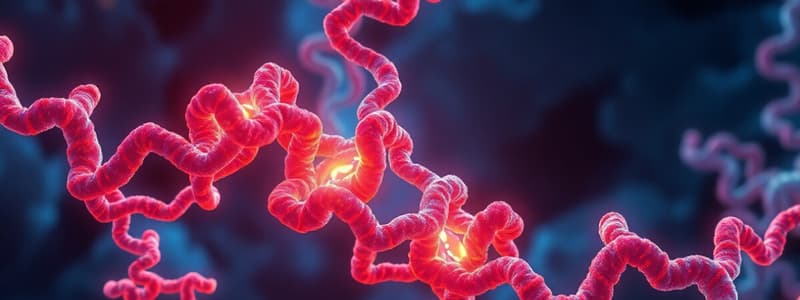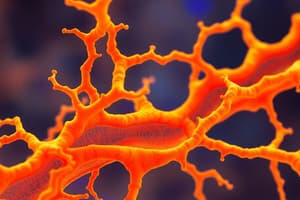Podcast
Questions and Answers
What type of collagen does not form fibrils or fibers?
What type of collagen does not form fibrils or fibers?
- Type II
- Type V
- Type I
- Type IV (correct)
Which amino acid is MOST prevalent in collagen composition?
Which amino acid is MOST prevalent in collagen composition?
- Hydroxyproline
- Hydroxylysine
- Glycine (correct)
- Proline
What type of collagen is classified as linking or anchoring collagen?
What type of collagen is classified as linking or anchoring collagen?
- Type IV
- Type II
- Type I
- Type VII (correct)
How can the amount of collagen in a tissue be determined?
How can the amount of collagen in a tissue be determined?
What characteristic amino acids contribute to the synthesis of collagen but are not incorporated into the protein itself?
What characteristic amino acids contribute to the synthesis of collagen but are not incorporated into the protein itself?
What characteristics define glycosaminoglycans?
What characteristics define glycosaminoglycans?
Which statements accurately describe laminin?
Which statements accurately describe laminin?
What role do integrins play in the extracellular matrix?
What role do integrins play in the extracellular matrix?
What property of glycosaminoglycans contributes to their hydrophilic nature?
What property of glycosaminoglycans contributes to their hydrophilic nature?
How are fibronectin and laminin similar?
How are fibronectin and laminin similar?
What is a key feature of the molecular structure of fibronectin?
What is a key feature of the molecular structure of fibronectin?
Which statement is false regarding integrins?
Which statement is false regarding integrins?
What type of cells primarily synthesize fibronectin?
What type of cells primarily synthesize fibronectin?
What is a primary characteristic of elastic fibers?
What is a primary characteristic of elastic fibers?
Which component is not part of elastic fibers?
Which component is not part of elastic fibers?
What staining method produces a black color for elastic fibers?
What staining method produces a black color for elastic fibers?
What is the role of lysyl oxidases in the context of fibrillar structures?
What is the role of lysyl oxidases in the context of fibrillar structures?
What is a distinguishing feature of reticular fibers during embryogenesis?
What is a distinguishing feature of reticular fibers during embryogenesis?
Which of the following statements about elastic fibers is true?
Which of the following statements about elastic fibers is true?
What type of fibers create flexible networks in organs subject to increased volume?
What type of fibers create flexible networks in organs subject to increased volume?
What color do elastic fibers appear when stained using Resorcin-fuchsin?
What color do elastic fibers appear when stained using Resorcin-fuchsin?
What is the molecular weight of proelastin before it polymerizes to form elastin?
What is the molecular weight of proelastin before it polymerizes to form elastin?
Which statement accurately describes the amino acid composition of elastin compared to collagen?
Which statement accurately describes the amino acid composition of elastin compared to collagen?
Which of the following best describes the stability of elastin's structure?
Which of the following best describes the stability of elastin's structure?
What unusual amino acids are formed in elastin through covalent reactions?
What unusual amino acids are formed in elastin through covalent reactions?
What type of cells primarily produce elastin in the body?
What type of cells primarily produce elastin in the body?
Which of the following statements about mast cells is accurate?
Which of the following statements about mast cells is accurate?
What characterizes dense connective tissue compared to loose connective tissue?
What characterizes dense connective tissue compared to loose connective tissue?
Which of the following bioactive substances is NOT typically released by mast cells?
Which of the following bioactive substances is NOT typically released by mast cells?
How do connective tissue mast cells differ from mucosal mast cells?
How do connective tissue mast cells differ from mucosal mast cells?
What is the primary function of mast cells in the context of tissue repair?
What is the primary function of mast cells in the context of tissue repair?
Which of the following features is characteristic of all mast cells?
Which of the following features is characteristic of all mast cells?
What is the function of leukotrienes released by mast cells?
What is the function of leukotrienes released by mast cells?
Which type of connective tissue is characterized by having fibers arranged in a parallel manner?
Which type of connective tissue is characterized by having fibers arranged in a parallel manner?
Flashcards are hidden until you start studying
Study Notes
Fibronectin
- Highly hydrated, observed as empty spaces upon dessication in mounted slides.
- Molecular Weight between 235 - 270 kDa; exists in dimeric form.
- Synthesized by fibroblasts and epithelial cells.
- Contains binding sites for cells, collagen, and glycosaminoglycans.
- Facilitates normal cell adhesion and migration.
Glycosaminoglycans (GAGs)
- Also termed mucopolysaccharides; consist of linear polysaccharides with repeating disaccharide units.
- Comprised of hexosamine (glucosamine or galactosamine) and uronic acids (glucuronic or iduronic acid).
- Heparan sulfate is notable for its high molecular weight (hundreds to thousands of kDa).
- GAGs are intensely hydrophilic, bind cations, and are crucial in maintaining tissue hydration.
Laminin
- Trimeric glycoprotein with a molecular weight of 200 - 400 kDa; possesses a cross-shaped structure.
- Primarily found in the basal laminae, aiding the adhesion of epithelial cells.
Integrin
- Functions as matrix receptors that recognize specific sequences on laminin, fibronectin, and various extracellular matrix proteins.
- Composed of heterodimers with α and β chains; acts as a crucial link between cells and the ECM.
Types of Collagen
- Type IV collagen forms sheet-like structures in basal laminae; does not form fibrils or fibers but exists as unpolymerized procollagen.
- Fibrillar collagens (Types I, II, III) are significant structural proteins that form fibrils.
- Type VII collagen serves as linking/anchoring collagen, connecting fibrillar collagens and ECM components; prevalent across numerous cells.
Collagen Composition
- Major amino acids include glycine (33.5%), proline (12%), and hydroxyproline (10%).
- Tissue collagen content can be quantified via hydroxyproline measurement.
- Unique characteristics include hydroxylation of proline and lysine, yielding hydroxyproline and hydroxylysine.
Elastic Fibers
- Composed of thin, branching fibers that form irregular networks, characterized by their yellow color in fresh samples.
- Capable of stretching up to 150% of their length while readily returning to the original shape (recoil).
- Composed of an amorphous region with elastin and a sheath of 14nm microfibrils.
Elastin
- Secreted as proelastin (molecular weight of 70,000), polymerizes to form elastin.
- Highly resistant to boiling and chemical extraction; not digested by trypsin.
- High in valine and alanine, and contains unique amino acids desmosine and isodesmosine.
Cells of Connective Tissue
- Connective tissue cells support epithelial structures and fill spaces between fibers and muscle sheaths.
- Most notable cell types include fibroblasts and macrophages, responsible for tissue maintenance and immune responses.
Mast Cells
- Oval to round cells (20-30μm), filled with basophilic granules; central, small nucleus.
- Metachromatic properties allow for color change of basic dyes from blue to purple/red.
- Key players in local inflammatory responses, releasing leukotrienes and various bioactive substances (e.g., histamine, heparin).
- Two subtypes: connective tissue mast cells (primarily heparin) and mucosal mast cells (primarily chondroitin).
Dense Connective Tissue
- Similar components to loose connective tissue but dominated by collagen fibers.
- Features fewer cells, with fibroblasts being predominant.
- Types include dense irregular connective tissue (fibers orient randomly) and dense regular connective tissue (provides multi-directional stress resistance).
Studying That Suits You
Use AI to generate personalized quizzes and flashcards to suit your learning preferences.




